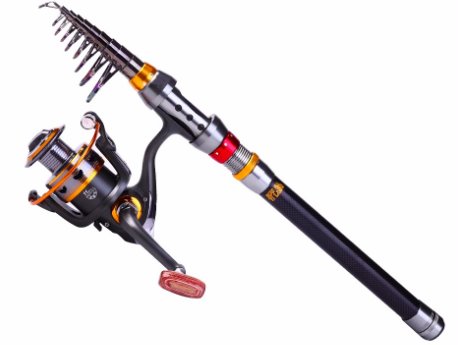FREE SHIPPING AND NO MINIMUM SPEND FOR ALL ORDERS!
FREE SHIPPING AND NO MINIMUM SPEND FOR ALL ORDERS!
Accessories
Check out our full lineup of yoga accessories to help you with your daily meditation practice and fitness goals...
Try our new Cork Yoga Brick for soft but solid support
Check out our full lineup of yoga accessories to help you with your daily meditation practice and fitness goals...

How To Choose A Fishing Rod and Reel
4 min read
With over 3 million people fishing recreationally each year and with over 23 million fishing activities in a year (1) fishing is one of the most significant outdoor activities undertaken by Australians. In the US the number of people fishing is over 46 million (2). No wonder there are so many choices when it comes to choosing a rod and reel. How do you choose a fishing rod and reel? It's time to demystify the options and help you narrow down the choices.
The best place to start is with you and your fishing requirements. Here are a few questions that will help qualify the right rod and reel for you.
- Are you buying for a kid, are you a beginner angler, intermediate or experienced?
- Where will you be fishing with the rod mostly? Off the beach, rocks, wharf/pier, boat or off a river bank.
- Are you doing any specialist fishing? e.g. fly fishing or deep sea.
- Are you planning on using live bait or lures?
If you have at least most of the answers to these questions you are on your way to a choosing the right rod and reel for you.
Fishing Rod Measurements and Specifications
Choosing a Rod Length
The length of the rod is measured from the tip to the end of the butt. Fishing rods range in length from about 1.2m (4 feet) all the way up to 4.3m 14 feet.
Larger rods often dissemble into several pieces for easier transportation. More popular now are the telescopic rods that collapse into a small unit for storage and expand again when it's time to fish.
- Average rod length is 6-8ft. Beginners should choose within that range with 7ft being a good place to start.
- Shorter rods cast shorter distances and are usually used in combination with lightweight tackle. They also allow you better manipulation at close quarters when you are fighting with a fish. They are perfect for fishing off a boat, pier or wharf.
- Shorter rods are the best for kids and beginners who are learning to cast. They will have better control over the shorter and lighter rod and will have less chance of swiping other anglers with any wayward casts.
- Shorter rods may be best for big game fishing however game fishing requires a specialist rod and careful consideration and investment.
- Shorter rods are also best for trolling or trawling, a type of fishing where the line is attached to a moving boat and drawn across the water.
- Fishing in estuaries and offshore a good rod size range is between 6-8ft.
- Longer rods (9ft-13ft) cast further distances and therefore are useful for surfcasting (fishing directly from the beach) or from rocks rather than a boat or pier.
- Longer rods are also used in fly fishing and with heavier lures.
Rod Action
The action of a rod is the point on the rod where it bends. This measurement ranges from "ultra light" to "heavy". A heavy action means it bends closer to the tip while a lighter action bends closer to the butt of the rod. Rod action is also influenced by material which is covered in the next section.
- A heavier action means a stiffer rod backbone. It is recommended for use with larger species of fish e.g. Bass, Snapper, Tuna, Salmon, Red Emperor.
- A lighter action rod is usually used with smaller species of fish e.g. Bream, Whiting, Blue Grenadier, Mackerel, Flathead.
Bait
In fishing, you are either using live bait or lures. A casting or live bait fisherman may want a more sensitive rod in order to be able to feel each small movement in the water. A lure fisherman may prefer a stiffer rod to be able to manipulate the rod and imitate the movement of the prey.
Rod material
Fishing rods are made of carbon fibre (also known as graphite), fibreglass, or a combination of both materials. The material that your rod is made of is related to its functionality and the kind of fishing that you will be doing. There are pluses and minuses for both materials.
- Carbon Fibre rods on the plus side are lighter, stiffer and sensitive. On the minus they are more brittle and more expensive than fibreglass rods. Carbon fibre rods are best suited to lure fishing as the angler to feel the action of the lure and the strike of the fish.
- Fibreglass rods on the plus side are more flexible, are very difficult to break and are normally less expensive. On the minus they are heavier. Fibreglass rods are best suited to bait fishing.
Choosing a Reel.
Rod choice is also determined by what kind of reel you will be using. Reel type is either spinning or casting. The different kinds of reels correspond to a fisherman's different needs. Each reel type has a matching rod. eg. Baitcaster Reel matched with Baitcaster Rod.
- A spinning reel is ideal for beginners because it allows for a greater rate of casting and reeling success. Spinning reels are less likely to get tangled. They work well with lighter lures and baits and work well with all-purpose rods.
- Spinning reels are also ideal for beginners, as they are easier to use than casting reels.
- A casting or baitcaster reel allows more control as you use your thumbs to control the accuracy of the cast. This, however, makes it more difficult to use. They are also used more often with heavier artificial lures.
Now that we have all the factors we are going to attempt to bring them all together in a simple chart. This is a guide only, ultimately choosing a rod and reel is a personal choice that you need to feel right with. You will find that most anglers have multiple rods and reels to suit different conditions. If you are starting out, get a kit that is going to suit across multiple conditions and you can specialise with other set ups once you have a good feel for your specific requirements. It is best to get something that is easy for you to manage and for you to enjoy yourself out there rather than to overstretch too far and have a miserable time spending all your fishing time in tangles.
Fishing Rod Selection Guide

We would love to help you with your fishing requirements: https://toysfreedelivery.com/collections/sporting-gear
References: (1) https://ozfish.org.au (2 )https://www.statista.com
Leave a comment
Comments will be approved before showing up.
